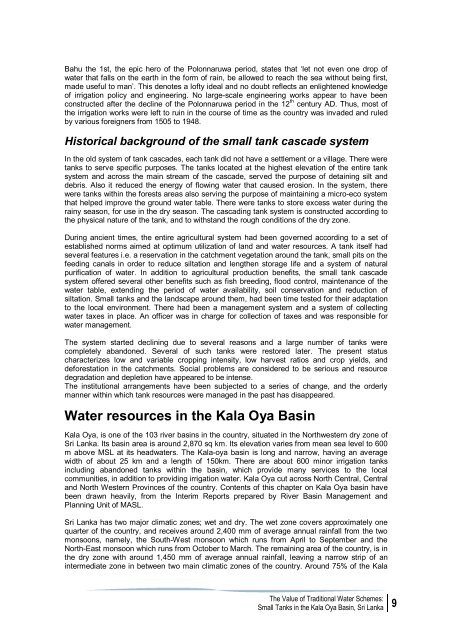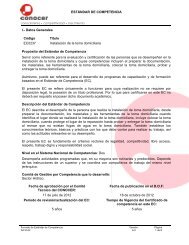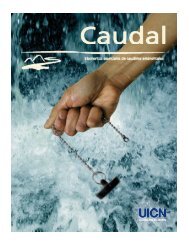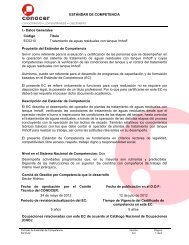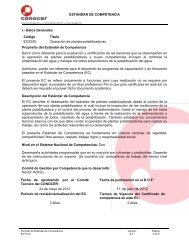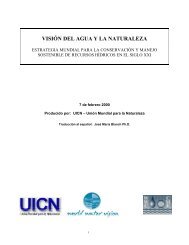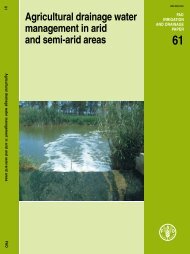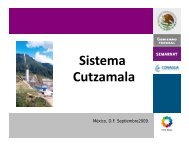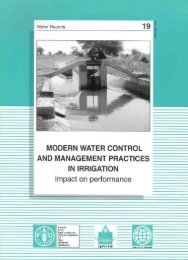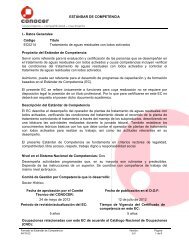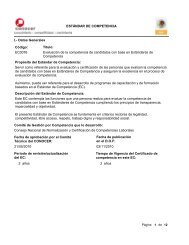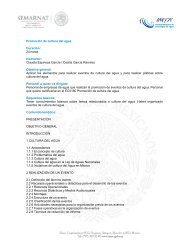Document - IUCN
Document - IUCN
Document - IUCN
You also want an ePaper? Increase the reach of your titles
YUMPU automatically turns print PDFs into web optimized ePapers that Google loves.
Bahu the 1st, the epic hero of the Polonnaruwa period, states that ‘let not even one drop ofwater that falls on the earth in the form of rain, be allowed to reach the sea without being first,made useful to man’. This denotes a lofty ideal and no doubt reflects an enlightened knowledgeof irrigation policy and engineering. No large-scale engineering works appear to have beenconstructed after the decline of the Polonnaruwa period in the 12 th century AD. Thus, most ofthe irrigation works were left to ruin in the course of time as the country was invaded and ruledby various foreigners from 1505 to 1948.Historical background of the small tank cascade systemIn the old system of tank cascades, each tank did not have a settlement or a village. There weretanks to serve specific purposes. The tanks located at the highest elevation of the entire tanksystem and across the main stream of the cascade, served the purpose of detaining silt anddebris. Also it reduced the energy of flowing water that caused erosion. In the system, therewere tanks within the forests areas also serving the purpose of maintaining a micro-eco systemthat helped improve the ground water table. There were tanks to store excess water during therainy season, for use in the dry season. The cascading tank system is constructed according tothe physical nature of the tank, and to withstand the rough conditions of the dry zone.During ancient times, the entire agricultural system had been governed according to a set ofestablished norms aimed at optimum utilization of land and water resources. A tank itself hadseveral features i.e. a reservation in the catchment vegetation around the tank, small pits on thefeeding canals in order to reduce siltation and lengthen storage life and a system of naturalpurification of water. In addition to agricultural production benefits, the small tank cascadesystem offered several other benefits such as fish breeding, flood control, maintenance of thewater table, extending the period of water availability, soil conservation and reduction ofsiltation. Small tanks and the landscape around them, had been time tested for their adaptationto the local environment. There had been a management system and a system of collectingwater taxes in place. An officer was in charge for collection of taxes and was responsible forwater management.The system started declining due to several reasons and a large number of tanks werecompletely abandoned. Several of such tanks were restored later. The present statuscharacterizes low and variable cropping intensity, low harvest ratios and crop yields, anddeforestation in the catchments. Social problems are considered to be serious and resourcedegradation and depletion have appeared to be intense.The institutional arrangements have been subjected to a series of change, and the orderlymanner within which tank resources were managed in the past has disappeared.Water resources in the Kala Oya BasinKala Oya, is one of the 103 river basins in the country, situated in the Northwestern dry zone ofSri Lanka. Its basin area is around 2,870 sq km. Its elevation varies from mean sea level to 600m above MSL at its headwaters. The Kala-oya basin is long and narrow, having an averagewidth of about 25 km and a length of 150km. There are about 600 minor irrigation tanksincluding abandoned tanks within the basin, which provide many services to the localcommunities, in addition to providing irrigation water. Kala Oya cut across North Central, Centraland North Western Provinces of the country. Contents of this chapter on Kala Oya basin havebeen drawn heavily, from the Interim Reports prepared by River Basin Management andPlanning Unit of MASL.Sri Lanka has two major climatic zones; wet and dry. The wet zone covers approximately onequarter of the country, and receives around 2,400 mm of average annual rainfall from the twomonsoons, namely, the South-West monsoon which runs from April to September and theNorth-East monsoon which runs from October to March. The remaining area of the country, is inthe dry zone with around 1,450 mm of average annual rainfall, leaving a narrow strip of anintermediate zone in between two main climatic zones of the country. Around 75% of the KalaThe Value of Traditional Water Schemes:Small Tanks in the Kala Oya Basin, Sri Lanka9


